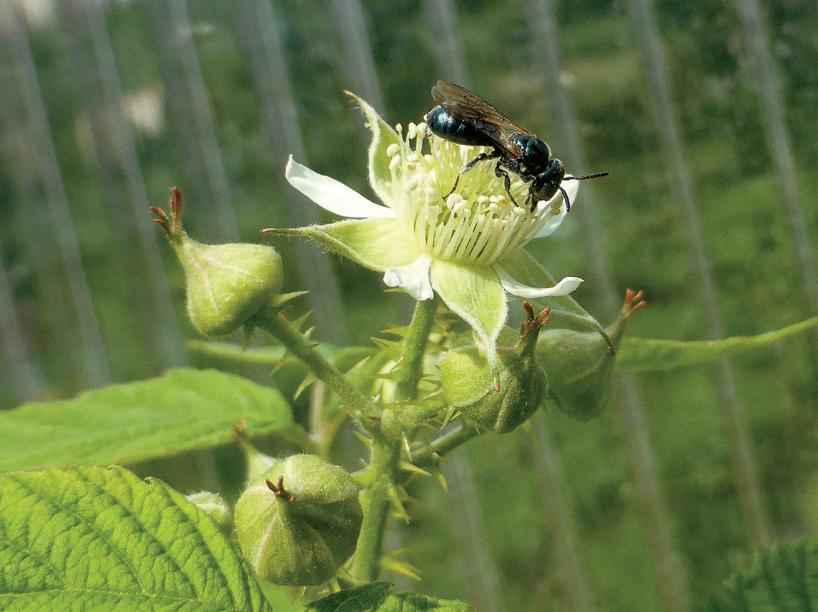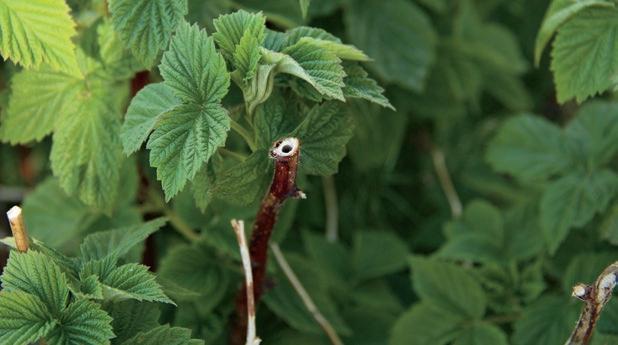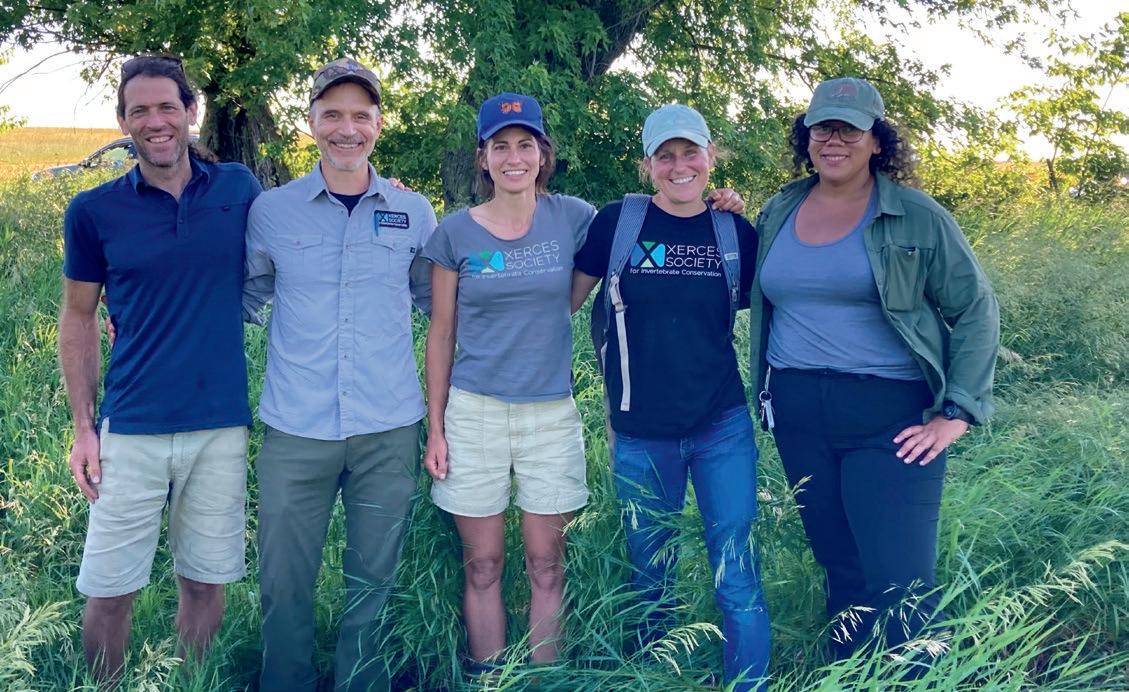
11 minute read
Beyond Flowers: On-Farm Habitat to Support Pollinator Nesting & Overwintering
BEYOND FLOWERS:
ON-FARM HABITAT TO SUPPORT POLLINATOR NESTING & OVERWINTERING
BY SARAH FOLTz JORDAN
When considering habitat for pollinators, there’s a (very understandable) tendency to focus on flowers. Flowers provide essential pollen and nectar for bees and other insects, and also add vibrant color and beauty to our farms, yards, and community spaces. However, flowers alone aren’t enough to meet the basic needs of pollinators. In order to help insects to build and sustain successful populations in our agricultural landscapes over the long-term, we also need to provide shelter for these animals, specifically by increasing the availability and quality of their nesting and overwintering habitat. So, where do insects make their homes? Given the astounding diversity in insects (even within “pollinators” and other more-narrow groupings), the answer isn’t simple. Together, the US & Canada are home to nearly 3,600 species of bees and roughly 12,400 species of parasitic and predatory wasps, each with their own unique morphology, habitat requirements, and highly sophisticated life history.
That said, there are a few running themes that are useful for farmers and other land stewards to know about. Most bees and solitary wasps in our region create small nests at varied depths beneath the soil. Others nest within dead plant stems or branches, often having preferences for those that are hollow or pithy enough for the insect to chew into. Some bees and many other insects find or build cozy cavities within tree snags or logs, with different insects settling in and moving out as the wood transforms through various stages of decay. Still other insects such as butterflies, fireflies, lady beetles, and ground beetles seek shelter in places that offer protection from predators and the elements, such as leaf litter and piles of rock or brush. Similarly, bumble bee nests are often found under brambles, tall grasses, brush, or rock piles, often associated with an abandoned mouse nest.
Unfortunately, manicured farms and yards rarely leave enough of these “messy” habitat features to support robust populations of pollinators and other wildlife. Farmers who do have these features often feel bad (rather than good) about it – the way you might feel about a mess you haven’t gotten around to cleaning up yet. Conversely, farmers might feel a little too good about the amount of noncrop “wildlife” areas on their farms, failing to notice that without attention and management, these areas have rapidly become choked with invasive plants that unfortunately aren’t serving wildlife the way we might imagine. Nesting habitat isn’t rocket science – the basic needs of pollinators can be met fairly easily – but sometimes we need a bit of a mentality shift and thoughtful attention to what’s happening both above and below ground, in both crop and non-crop areas.
Here at Xerces, we have recently developed a short guide – “Nesting and Overwintering Guidelines for Pollinators and Other Beneficial Insects” – focused on a variety of natural nesting habitat features that can be readily incorporated into most landscapes. For farms, I’ve distilled our recommendations as follows (but feel free to check out the full guidelines online for additional details):
• Ensure your farmscape includes a diversity of species that are known to provide resources for nesting (see Tables 1, 2, & 3 in this article for ideas). For example, an abundance of native bunch grasses can help ensure ground-nesting bees have access to undisturbed soil. Wild roses (Rosa), maples (Acer), basswood (Tilia), and juneberry (Amelanchier) provide leaf-tissue for leaf-cutter bees to use to line the cells of their nests. Pithy shrubs like elderberry (Sambucus), highbush cranberry (Vibernum), and raspberries (Rubus) make fantastic homes for stem-nesting bees, as do some of our wildflower stems like bee balm (Monarda) and hyssop (Agastache). A few plants that are often thought of as weedy or worthless, such as box-elder (Acer neguda) and sumac (Rhus), are actually quite valuable for bee nesting. While you might not go out of your way to plant these more common species, you may wish to prune them occasionally to increase nesting, and make sure that they aren’t exposed to pesticides or other broadscale disturbances.
• Establish native insectary strips in crop fields or edges to benefit ground-nesting bees, ground
beetles, and other soil-dwelling insects. On organic farms utilizing tillage for weed control, these untilled areas are critical refugia from soil disturbance. Placement of the strips in close proximity to crops helps you meet the nesting and foraging needs of beneficial insects and build their populations in the very places you need them most.
• Manage wildflower areas and hedgerows with stem-nesting in mind. Choose plants that support stem-nesters (see Tables 1 & 2). For wildflower habitat: leave dead flowers with seed heads intact over the winter, and prune back the stems to 8 to 24 inches or so in spring to provide “stem stubble” with cut ends that bees can access (see Diagram for more details).
For larger areas, you may wish to prune only select high-value stems (rather than everything), or opt for a high mow in very early spring, rather than hand-pruning. For hedgerows and shrubs: prune branches or canes back in spring to create cut ends that nesting bees can access. Remember, cutting dead stems or pithy branches on our part is simply a way to provide stem-nesting bees with an entrance to the stem where they might wish to make a nest. Deer and rabbit browse of plant stems or branches is another way bees gain access to these nest sites in the wild.
• Retain brush, snags, logs, and rock-piles as nesting habitat and shelter for all sorts of wildlife.
• Watch for and protect areas with dense aggregations of ground-nesting bees. Typically these nests are only active for a very small window of time in spring, and may occur on field roads, lawn areas, slopes with eroded soils, or even within the fields of some crops such as blueberries or squash.
• In fall: leave the leaves. Most farmers I know don’t have time for raking the yard, but here’s your excuse if you need it. In cold climates, the vast majority of butterflies and moths use leaf litter for winter protection of eggs, caterpillars, chrysalises, or adults. Similarly, bumble bee queens often rely on leaf litter for protection. At the end of summer, the mated queens burrow an inch or two into the earth to hibernate; an extra thick layer of leaves is welcome additional protection from the elements.
• Pesticides – even organic approved – can be problematic to pollinators. Develop an IPM plan that considers pollinators, use prevention and other non-chemical approaches whenever possible, choose least toxic pest protection options, and protect both flowers and nesting habitat from pesticide exposure. See Xerces guidance document “Organic Pesticides: Minimizing
Risks to Pollinators and Beneficial Insects”
• Install a habitat sign to increase the educational value of your efforts and spread awareness about the importance of pollinator conservation in your community.
SCIENTIFIC NAME COMMON NAME USE BY BEES
Agastache foeniculum anise hyssop Stem for nesting
Artemisia campestris & ludoviciana field sagewort, prairie sage Plant hairs for lining nest
Chamaenerion angustifolium fireweed Leaves for cell partitioning
Cirsium spp. native thistles Stem for nesting
Desmodium canadense showy ticktrefoil Leaves for cell partitioning
Eutrochium spp. Joe Pye weed Stem for nesting
Fragaria virginiana wild strawberry Leaves for cell partitioning
Helianthus grosseserratus sawtooth sunflower Stem for nesting
Helianthus maximiliani Maximilian sunflower Stem for nesting
Liatris spp. blazing star Stem for nesting
Monarda fistulosa wild bergamot, bee balm Stem for nesting
Oenothera biennis evening primrose Petals for cell partitioning Oligoneuron rigidum stiff goldenrod Stem for nesting
Silphium perfoliatum cup plant Stem for nesting Symphyotrichum spp. asters Stem for nesting
Vernonia fasciculata ironweed Stem for nesting
What about bee hotels? Although artificial nesting options such as bee blocks and bee hotels can be fun and educational, we focus on natural nesting habitat because these features often better mimic the natural nest site density of insects and break down naturally with time, limiting disease issues. Moreover, natural nesting features often provide multiple conservation (and human) benefits. A pruned raspberry hedge, for example, can provide excellent nesting habitat for a variety of insects, along with abundant edible fruit for humans, and blossoms in springtime when pollen and nectar resources can be limited. Similarly, an appropriately managed wildflower planting can provide
SCIENTIFIC NAME COMMON NAME USE BY BEES
Acer negundo, rubrum, saccharum & other spp. box elder, red maple, sugar maple, & other maples Branches for nesting, leaves for cell partitioning
Amelanchier spp. Juneberry/serviceberry Leaves for cell partitioning
Cornus spp. dogwood Leaves for cell partitioning Fraxinus nigra, pennsylvanica black ash, green ash Leaves for cell partitioning
Lonicera canadensis fly honeysuckle Leaves for cell partitioning Rosa arkansana, blanda, woodsii, and other spp.
Rubus pubescens and other spp. prairie, smooth, woods, and other wild rose
Dwarf raspberry and other raspberry/blackberry Stem for nesting; leaves & petals for cell partitioning Stem for nesting; leaves for cell partitioning
Rhus glabra and typhina smooth & staghorn sumac Stem for nesting; leaves for cell partitioning
Sambucus nigra black elderberry Stem for nesting
Sambucus race mosa red elderberry Stem for nesting Tilia americana basswood Leaves for cell partitioning Toxicodendron vernix poison sumac Stem for nesting
Viburnum trilobum high bush cranberry Stem for nesting
Credit: Jennifer Hopwood
A nest entrance in raspberry cane. The small carpenter bee, Ceratina, is an important pollinator of raspberries and nests in pruned raspberry canes.

SCIENTIFIC NAME COMMON NAME USE BY BEES
Andropogon gerardii big bluestem
Bouteloua curtipendula side-oats grama
Bouteloua gracilis, hirsuta blue grama, hairy grama
Bromus kalmii prairie brome
Calamagrostis canadensis bluejoint
Elymus canadensis Canada wild rye
Eragrostis spectabilis purple lovegrass
Eragrostis trichodes sand lovegrass
Hesperostipa spartea Porcupine grass
Koeleria macrantha prairie junegrass
Panicum virgatum switchgrass
Schizachyrium scoparium little bluestem
Sorghastrum nutans Indian grass
Sporobolus cryptandrus sand dropseed
Sporobolus heterolepis prairie dropseed Stem for nesting, Soil/cavity at base of plant for nesting Soil/cavity at base of plant for nesting Soil/cavity at base of plant for nesting Soil/cavity at base of plant for nesting Soil/cavity at base of plant for nesting Soil/cavity at base of plant for nesting Soil/cavity at base of plant for nesting Soil/cavity at base of plant for nesting Soil/cavity at base of plant for nesting Soil/cavity at base of plant for nesting Soil/cavity at base of plant for nesting Soil/cavity at base of plant for nesting Stem for nesting, Soil/cavity at base of plant for nesting Soil/cavity at base of plant for nesting Soil/cavity at base of plant for nesting
nesting sites, pollen, and nectar for bees; host plants and overwintering habitat for butterflies; and abundant food for songbirds. Remember, all parts of a plant can be valuable to insects, even after they have withered and browned and become less aesthetically pleasing to us. Since the availability of nesting and overwintering habitat is one of the most important factors influencing populations of native bees and other beneficial insects, our small efforts can really go a long way in helping insects find what they need on our farms.
If you are interested in creating or enhancing pollinator habitat on your farm, we are here to help! Xerces Society has staff across the country offering technical support to producers. Additionally, the USDA’s Natural Resource Conservation Service offers two programs, the Environmental Quality Incentives Program (EQIP) and the Conservation Stewardship Program (CSP), that could help fund your habitat projects. Contact Xerces or your local NRCS field office to ask about opportunities. In closing, it is important to note that our knowledge of bee nesting requirements is still somewhat limited, and we’re always learning more about what plants are preferred by different types of bees across the country.
What are you seeing on your farm? If you have a sighting to report (ideally of a specific plant used by a specific bee), please email beenesting@xerces.org. Your contributions will help us to build our database of plants used by nesting bees!
Based out of Northeast Minnesota, Sarah Foltz Jordan leads Xerces’ upper Midwest native bee and monarch habitat restoration efforts, focused primarily in agricultural landscapes. Working closely with farmers across the region, Sarah tests and promotes a variety of organic habitat restoration methods on fruit, vegetable, and grain farms.
LEARN MORE FROM THE xERCES SOCIETY
Join Sarah Foltz Jordan and Leif Richardson of Xerces Society at a webinar about providing nesting habitat for bees!
SEpTEMBER 29, 2022 12 p.M. CT
Register at xerces.org/events/webinars
FURTHER READING... Download a copy of the publication mentioned in the article, “Nesting & Overwintering Habitat For Pollinators & Other Beneficial Insects” at xerces.org/publications
Please reach out to Xerces staff for pollinator-related support. We are thrilled to introduce two new staff in the Upper Midwest, Micah Kloppenburg (far left), our Wisconsin Pollinator Habitat Conservation Specialist based in Madison, and Stefanie Steele (far right), our Urban Farm Pollinator Specialist based in Detroit. In the center from left to right are Mace Vaugh who co-directs our Pollinator Program; Sarah Foltz Jordan (bio above), and Karin Jokela, our Farm Bill Biologist based in Farmington, MN. Photo: Steve Bertjens, Wisconsin NRCS.










